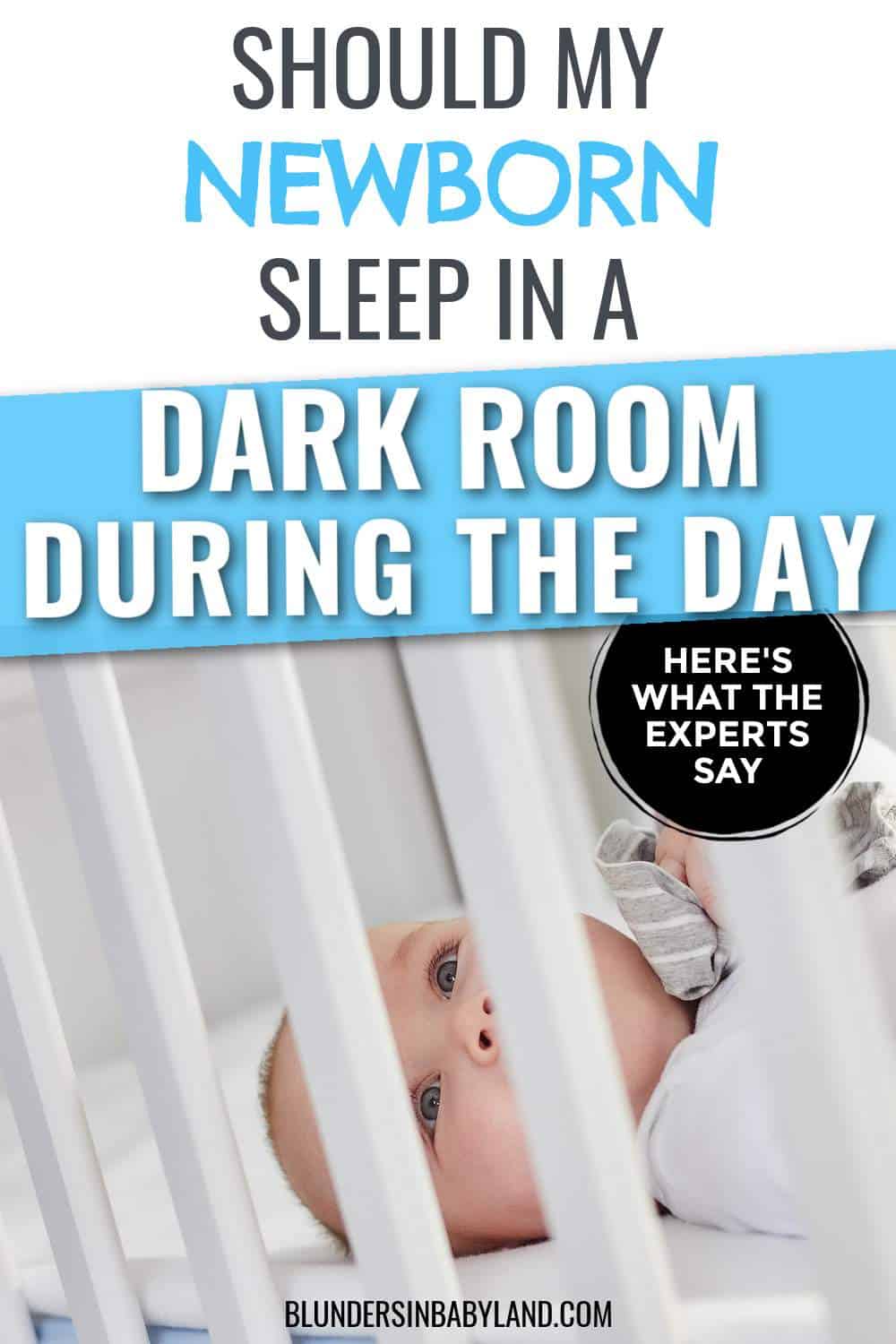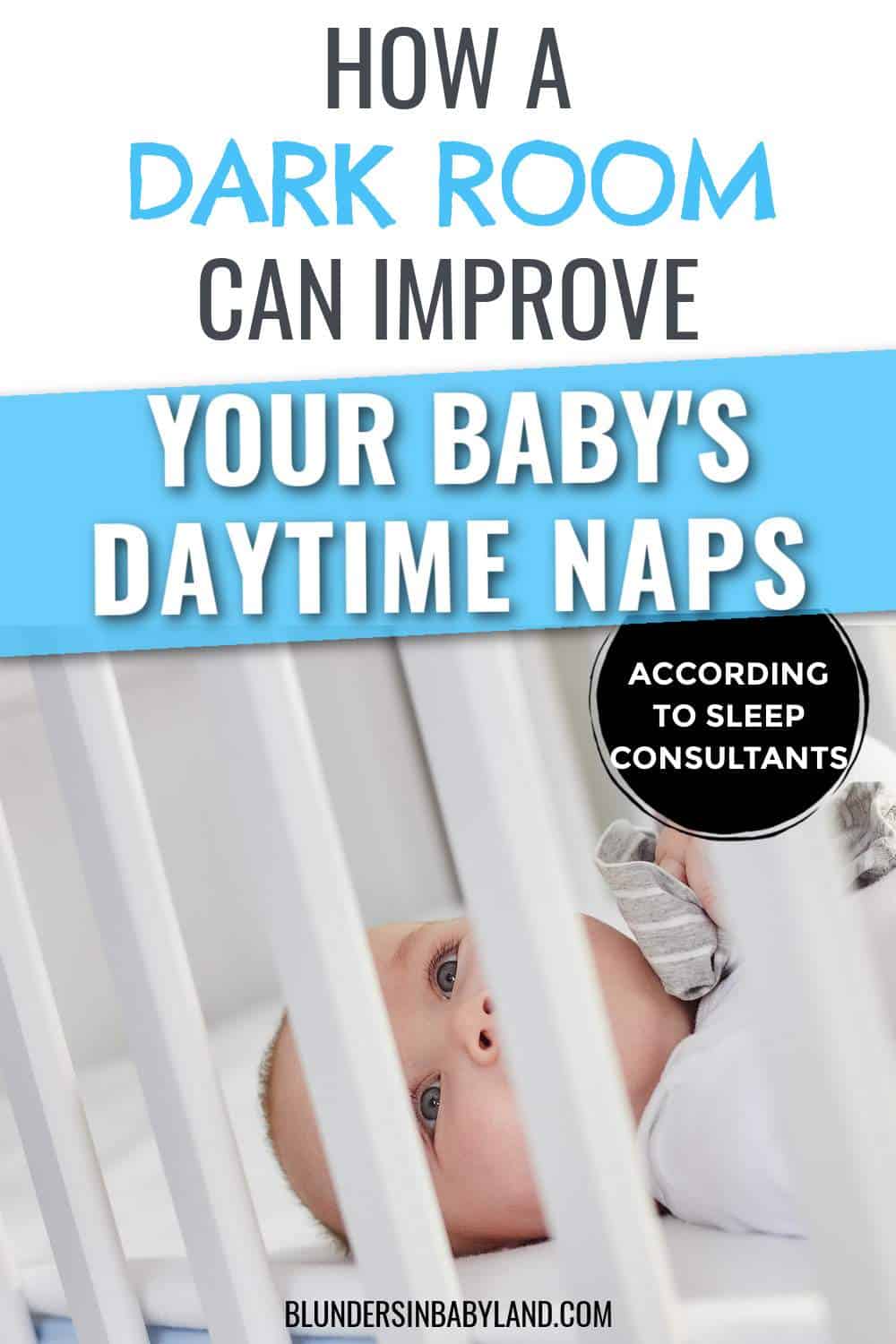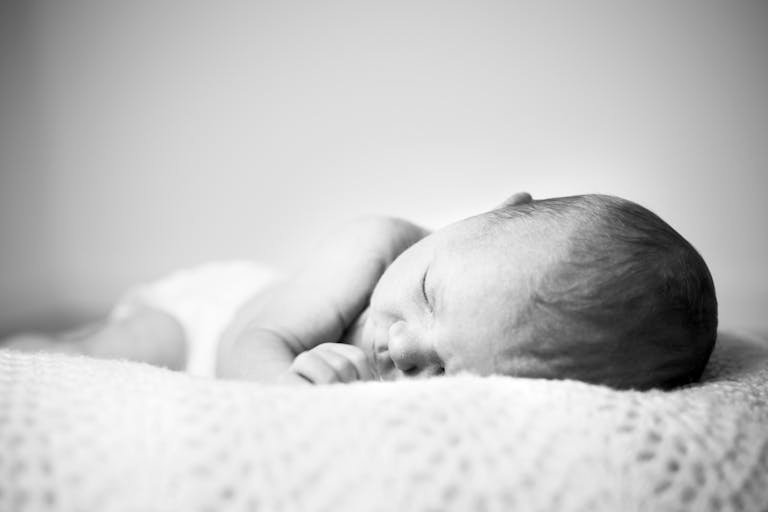Should Newborn Daytime Naps Be in the Dark: The Sleep Consultants Say Yes
Should newborn daytime naps be in the dark? This seems like a simple question, but if you ask five different moms, you’ll get five different answers. In this post, I’m sharing some of the best sleep practices from my favorite sleep consultants to help you decide what’s best for your child.
We all want to help our baby develop healthy sleep habits.
A sharp topic of debate amongst moms right now: should newborns should sleep in a dark room. One set of moms will emphatically say, “No, babies need to learn how to sleep any room, without the aid of darkness.”
The other half will emphatically disagree.
Talk about frustrating!
As a new mom, I asked this exact question and got 2-3 different answers. At this point, you just want to help your baby sleep, not hear more opinions. So, I compiled advice from my favorite sleep experts to help you decide for yourself what’s best for your little one.
We’ll discuss everything you need to know: how darkness can aid your little’s daytime sleep, how to make your nursery dark, and possible negatives to letting your baby sleep without light.
By the end of this article, I hope you’ll feel confident (or at least hopeful) that more rest is coming your way!

Should newborn daytime naps be in the dark?
Straight answer from the sleep experts I’ve learned from: Yes. And no.
Let me explain.
Newborns sleep anywhere, with just about any condition. However, this won’t be the case for long.
Board certified pediatric sleep physician, Dr. Olufunke Afolabi-Brown, teaches a fantastic infant sleep course over at Babycenter.com. In her course, she stresses the importance of creating a dark nursery for younger babies.
She warns that after 4 months, even the tiniest bit of light can impact your baby’s sleep.
After 12 weeks, your baby’s sleep cycle begins to mature. He goes from two sleep stages to four. Every 45(ish) minutes, he will transition into the next sleep cycle. When that happens one of two things will occur: your baby will either wake up or he’ll fall into a deep sleep.
If your little one is snoozing in a bright room, chances are, that nap will be over when the transition hits. On the other hand, a quiet, cozy retreat will encourage him to get back to sleep.
How Darkness Can Help Your Baby Sleep Better
That explains why a 4-month old would sleep in the dark. So, why should newborns daytime sleep be in the dark? Let’s dig in to how darkness will help your baby to sleep and stay asleep.
Melatonin Production
Many babies are born with day/night confusion. While it’s true that exposure to light during the day will help establish a healthy sleep and wake schedule, light may short circuit his production of melatonin.
Melatonin is responsible for helping us sleep. According to the Sleep Foundation, darkness helps us produce melatonin. Light, on the other hand, makes production stop.
Your little one has an undeveloped circadian rhythm. Which means, he’s taking all of his cues from his environment right now. Darkness produces melatonin, which helps him go to sleep. Meanwhile, light triggers his body to stop producing melatonin. Which, of course, halts baby’s nap.
Associated with the Womb
Think about it: in your womb, there were no night lights or rays of sunshine stealing in from the window. One might argue that your baby is more comfortable in darkness than light.
By creating a dark sleep environment, you can create a familiar setting for your newborns will love.
Reduces Stimulation
In other words, there’s nothing to look at.
Why sleep when your baby can stare at the birds on his mobile? Everything is so new and exciting for babies. Darkness removes those distractions and creates a restful environment that only encourages sleep.
Initiates Your Bedtime Routine
Now, I say “bedtime routine” but this totally applies to nap time as well. I am a big fan of baby nap rituals. I talk about them a lot on this blog!
This is just a consistent and specific chain of actions you perform before laying your baby down for a nap. The key is consistency. Eventually, your baby will recognize this routine, and understand that it’s time to wind down and get some shut-eye. Just think of it as a learned behavior!
Some sleep experts believe that babies recognize routines as early as 8 weeks.
Darkness is a very important component of your sleep ritual. Once you dim the lights and tell baby it’s time for a nap, his mind makes the connection, while the rest of his body enjoys the benefits of melatonin production.
Bedtime routines don’t have to be an elaborate process, either.
My daughter’s routine looks like this:
- I tell her it’s time for a nap (don’t be surprised if this initiates the waterworks though)
- I dim the lights
- Change her diaper
- Sing her a song
- Lights out
- Lay her in the crib
The whole process takes maybe 5-10 minutes. However, sometime between dimming the lights and leaving the room, she is all set to catch some zZzs.
Is It Okay for a Baby to Nap in a Dark Room?
I think what you’re really asking is, will my baby be scared in total blackness? Or worse, is it cruel for your baby to sleep in total darkness?
I truly believe it is okay for babies to sleep in total darkness.
When your baby sleeps in a pitch-black room, she isn’t thinking, “Wow, it’s dark in here and I’m scared.” That environment is more familiar and comfortable. It’s the closest thing to a womb that your child’s had since he’s actually been in your womb.
Now, an older baby or toddler’s nursery might be a different story. Around 2-3 years, children start to get scared of the dark. That’s about the time you might consider using a little light.
How Dark Should My Baby’s Room Be and How To Tell If It’s Dark Enough
Most babies don’t need total darkness to sleep. But some do. As I mentioned earlier, it also depends on your little one’s age.
For example, my children as infants needed their nurseries completely, 100% dark. Otherwise, they would wake up at the crack of dawn, or they would very easily wake at the 45-minute mark during their nap times. However, as they grew, only a dim room was required.
If your baby is consistently waking up when the sun rises or waking every 45 minutes into his nap, it’s time to use the hand test.
I learned this trick from Sleep consultant Cara from Taking Cara Babies (the creator of the sleep class that helped my own daughter finally sleep for longer stretches). Basically, when you’re in the nursery, hold your hand in front of you. If you can still see it, your nursery isn’t dark enough.
Remember, this level of darkness isn’t necessary for all babies. However, if you’re constantly struggling with sleep woes, darkening your nursery could be the answer.
RELATED POST: The Taking Cara Babies Review
Will My Baby Become Dependent on Darkness if His Nursery is Too Dark?
You know, I used to wonder the same thing. Sure, I can make my nursery pitch-black, but what about when my little girl stays at Grandma’s house? Or falls asleep on a long car ride?
If this is a big concern, Cara recommends gradually adding light into the nursery. We’re talking just a little bit of light, maybe underneath the curtains or from a nightlight, not throwing the curtains open and letting the sunshine pour in.
I followed this approach with my girls and it worked out great. However, after allowing a little bit of sunshine to creep into my daughter’s nursery, she did started waking significantly earlier in the morning.
This is a trade-off I’m willing to make. We’re at the stage where she is napping at her grandparents house semi-frequently, pitch-black isn’t an option.
3 Easy Tips to Make the Room Dark
How should newborn daytime naps be in the dark? You never know how hard it is to make a room absolutely pitch-black, until you’ve tried to do it. Light is everywhere. Below are a few tips that helped me.
Buy Blackout Curtains
This is the quickest, easiest way to create a cozy, dark environment. I wrote a whole post about my favorite blackout curtains and where you can get them.
While you’re shopping, make sure you look for “100% blackout” and avoid “room darkening.”
Use Velcro Blackout Blinds
If you already have a pair of curtains you love and can’t imagine replacing them, try installing a blackout film. Parents love EZ Blackout. Basically, you receive 36”x48” blackout screen that you cut to your specific window size. Simply install the velcro tape around your window frame and viola! No more sunshine.
Amazon also sells blackout paper shades, which are also easy to install, which I purchased for my own house (along with a really cute pair of blackout drapes from Target).
Use a Blackout Rod
These blackout rods allow your curtains to curve around the sill and against wall, blocking out sunshine from the sides of your window. Make sure you install them high enough and order curtains long enough to block out sunshine from above and below the window.
I Know My Baby Should Sleep in a Dark Room…Now What?

When my oldest daughter was a month old, I begged her–yes, begged–her to nap. It was messy.
So first, a word of encouragement: Getting your baby to nap during the day is a bear. Don’t be discouraged if your baby doesn’t sleep during the day like a pro at first.
I promise, this time will pass quickly. Keep in mind that you’re setting the foundation for great night sleep later, with that ultimate, lofty goal to sleep through the night. Right now, things are sporadic and messy, but keep at it and you’ll achieve longer, more predictable stretches of sleep. It will happen!!
Until then, I hope these tips help you squeeze out a few great naps. Add some blackouts and really commit to create a cozy retreat for your baby to get some rest. See if it helps. You both deserve it!
Feel free to snag my baby sleep troubleshooting sheets as well. They’re free. I used them to figure out my daughter’s nappy time struggles.
POSTS RELATED TO: SHOULD NEWBORN DAYTIME NAPS BE IN THE DARK?
- How to Get Your Breastfed Baby to Sleep Through the Night
- Where Should My Baby Nap During the Day: Getting Baby to Sleep Better






